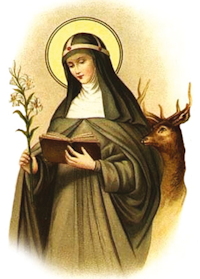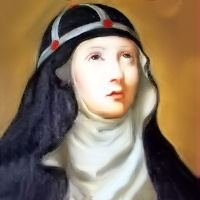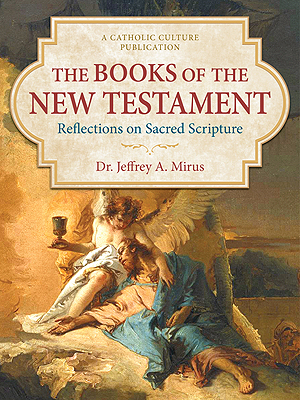Lent: March 24th
Wednesday of the Fourth Week of Lent
Other Commemorations: St. Catherine of Sweden, Virgin (RM)
» Enjoy our Liturgical Seasons series of e-books!
"Do not be amazed at this, because the hour is coming in which all who are in the tombs will hear his voice and will come out, those who have done good deeds to the resurrection of life, but those who have done wicked deeds to the resurrection of condemnation." (Jn. 5:28-29)
Before the reform of the Roman Calendar this was the feast of St. Gabriel. This feast has been transferred to September 29 which is also the feast of Sts. Michael and Raphael.
This day was called the 'Feria of the great scrutiny,' because in the Church of Rome, after the necessary inquiries and examinations, the list of the catechumens, who were to receive Baptism, was closed. The Station is held in the basilica of St. Paul outside the walls, both because of the size of the building, and also in order to honor the apostle of the Gentiles by offering him these new recruits, which the Church was about to make from paganism. The reader will be interested and edified by a description of this ceremony.
Meditation - Submission and Christian Obedience
Continual submission to the holy will of God is the most universal of all virtues and its practice should be most familiar to you, since at every moment there arise opportunities of renouncing your own will and submitting to the will of God. His will is always easy to recognize. God has willed that all things that are extremely necessary should also be very easy to obtain. The sun, for instance, and air and water, and the other elements are most necessary for man's natural life; so, also, these things are common and freely available to everyone.
In the same way, since God has placed you in this world only to do His holy will, and your salvation depends upon this, it is, therefore, extremely necessary that you should easily know God's will in all that must be done. So, He has made it easily recognizable, manifesting His holy will in five chief ways which are very certain and evident:
- by His commandments;
- by His counsels;
- by the laws, rules and obligations of our state in life;
- by the authority of those placed over you or directing you;
- by events, since every happening in an infallible sign that God so wills, either by absolute or by permissive will.
St. Catherine of Sweden
Catherine of Sweden, Saint, the fourth child of Saint Bridget of Sweden (q.v.) and her husband, Ulf Gudmarsson, b. 1331 or 1332; d. March 24, 1381. At the time of her death St. Catherine was head of the convent of Wadstena, founded by her mother; hence the name, Catherine Vastanensis, by which she is occasionally called. At the age of seven she was sent to the abbess of the convent of Riseberg to be educated and soon showed, like her mother, a desire for a life of self-mortification and devotion to spiritual things. At the command of her father, when about thirteen or fourteen years old, she married a noble of German descent, Eggart von Kürnen. She at once persuaded her husband, who was a very religious man, to join her in a vow of chastity. Both lived in a state of virginity and devoted themselves to the exercise of Christian perfection and active charity. In spite of her deep love for her husband, Catherine accompanied her mother to Rome, where St. Bridget went in 1349.
 Soon after her arrival in that city Catherine received news of the death of her husband in Sweden. She now lived constantly with her mother, took an active part in St. Bridget's fruitful labors, and zealously imitated her mother's ascetic life. Although the distinguished and beautiful young widow was surrounded by suitors, she steadily refused all offers of marriage. In 1372 St. Catherine and her brother, Birger, accompanied their mother on a pilgrimage to the Holy Land; after their return to Rome St. Catherine was with her mother in the latter's last illness and death.
Soon after her arrival in that city Catherine received news of the death of her husband in Sweden. She now lived constantly with her mother, took an active part in St. Bridget's fruitful labors, and zealously imitated her mother's ascetic life. Although the distinguished and beautiful young widow was surrounded by suitors, she steadily refused all offers of marriage. In 1372 St. Catherine and her brother, Birger, accompanied their mother on a pilgrimage to the Holy Land; after their return to Rome St. Catherine was with her mother in the latter's last illness and death.
In 1374, in obedience to St. Bridget's wish, Catherine brought back her mother's body to Sweden for burial at Wadstena, of which foundation she now became the head. It was the mother-house of the Brigittine Order, also called the Order of St. Savior. Catherine managed the convent with great skill and made the life there one in harmony with the principles laid down by its founder. The following year she went again to Rome in order to promote the canonization of St. Bridget, and to obtain a new papal confirmation of the order. She secured another confirmation both from Gregory XI (1377) and from Urban VI (1379), but was unable to gain at the time the canonization of her mother, as the confusion caused by the Schism delayed the process. When this sorrowful division appeared she showed herself, like St. Catherine of Siena, a steadfast adherent of the party of the Roman Pope, Urban VI, in whose favor she testified before a judicial commission. Catherine stayed five years in Italy and then returned home, bearing a special letter of commendation from the pope. Not long after her arrival in Sweden she was taken ill and died. In 1484 Innocent VIII gave permission for her veneration as a saint and her feast was assigned to March 22 in the Roman Martyrology. Catherine wrote a devotional work entitled "Consolation of the Soul" (Sielinna Troest), largely composed of citations from the Scriptures and from early religious books; no copy is known to exist. Generally she is represented with a hind at her side, which is said to have come to her aid when unchaste youths sought to ensnare her.
—Excerpted from The Catholic Encyclopedia, J.P. Kirsch
Patronage: Vadstena, Sweden; against abortion; for healing and protection from miscarriage
Symbols and Representations: Brigittine abbess with a hind at her side; Brigittine holding a lily; Brigittine dressing a poor man’s wounds; Brigittine being brought Communion on her death bed.
Highlights and Things to Do:
- Read more about St. Catherine of Sweden:
- Visit the Brigidine Sisters website and read about St. Catherine.






